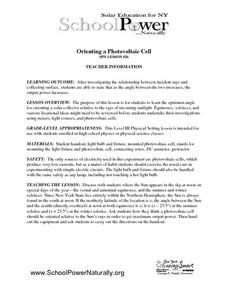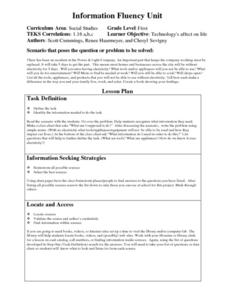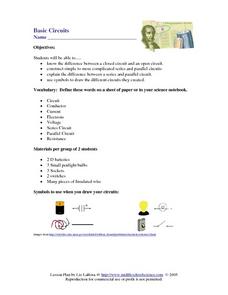Curated OER
Electricity and Magnetism: Are They Related?
Students explore electricity and magnetism. Through the use of role play, students simulate being a scientist. Experiments are performed during the simulation to discover the relationship between electric current and magnetism. After...
Curated OER
Lesson 2: Energetic Ideas
Pupils review what they know about energy safety, identify potential safety hazards associated with use of electricity and natural gas, and recognize that scientific information can be communicated in various ways by creating comic...
Curated OER
Pickle Juice
Pupils generate experimental questions regarding conductors of electricity, plug cord into pickle, and measure and graph voltage drop across electrodes. Students then compare to variety of other conductors of their choosing.
Curated OER
Orienting a Photovoltaic Cell
Students explore the optimum angle for orienting a solar collector relative to the rays of incoming sunlight. They review equinoxes, solstices, and various locational ideas before students investigate using meters, light sources, and...
Curated OER
Technology's Affect on Life
First graders read and analyze hypothetical scenario in which accident at local power company causes homes and businesses to be without electricity for five days. Students create chart listing which tools, appliances, and equipment would...
Curated OER
Electromagnets
Students are introduced to the relationship between electricity and magnetism. Using a compass, they observe and record the effects of placing the object near magnetic fields and electric currents. They also experiment using a steel and...
Curated OER
Fossil Fuels, Who Needs Them
Ninth graders explore how electricity is created and distributed through alternative production methods. Students participate in hands-on activities, research, lecture based instruction, and CD ROM resources.
Curated OER
MagLev Train System Activity
Young scholars are able to analyze practices that affect the use, availabiltiy, and management of natural resources. They are able to show that the forces of friction retards motion. Students investigate electricity and magnetism as...
Curated OER
Electricity Layered Curriculum
Students describe how electric charges exert forces on each other as well as compare the strengths of electric and gravitational forces. They distinguish between conductors and insulators. In addition, students examine voltage and...
Curated OER
School House Rock! Science Rock
Middle schoolers use common household and classroom objects to generate static electricity and study its effects. They discuss the video Science Rock CD called Electricity, Electricity. The video explains many things about electricity.
Curated OER
MINI-UNIT on ELECTRICITY
Students identify hypotheses related to static electricity, to begin to test the hypotheses, to begin to develop conclusions related to observations, to demonstrate that like charges repel and unlike charges attract each other, to name...
Curated OER
Windmill activity
Students explore how to build an efficient windmill design by taking into account how the lift and drag caused by the movement of wind can be used to make the blades of the turbine move. Through their readings, hypothesis and by trail...
Curated OER
Electricity/Magnetism
Fourth graders explore magnets as fundamental parts of generators and how they are used to produce current electricity. They distinguish between the north and south pole of magnets and the difference between repel and attract. Students...
Curated OER
Physical Science: Solar Energy
Students review and discuss how Solar energy and electricity produce light and heat. They create a photo/picture journal and include pictures taken during solar energy activities to a PowerPoint slide presentation.
Curated OER
What is the Underlying Causality of a Simple Circuit?
Students explore simple circuitry. They compare four models of circuits and explain how each works. Students contrast the cyclic cequential and cyclic simultaneous models using a shower curtain illustration and software simulation.
Curated OER
TE Activity: Build a Charge Detector
Young scholars examine how electrical force takes place between two objects by building an electroscope. They apply the electroscope to determine an objects' charge intensity and to see what factors influence electric force.
Curated OER
Bulbs & Batteries Side by Side
Learners build parallel circuits, exploring how they function and looking at their unique features. They describe how current changes when batteries are added in parallel or removed from a parallel arrangement, demonstrate the process of...
Curated OER
Wire Maze
Pupils investigate what causes electrical circuits to work. They construct a wire circuit and pass a paperclip through the maze, trying not to touch the wire, and answer discussion questions.
Curated OER
Conserving Electricity: Turn It Off
Second graders explore causes of air pollution and relate them to energy conservation.
Curated OER
Switcheroo
Students construct a simple switch and determine what objects and what types of materials can be used to close a switch in a circuit and light a light bulb.
Curated OER
Electrifying the World
Students explore the fundamental concepts of electricity. They examine different circuit diagrams to study how electricity flows. They finish by creating their own simple circuit.
Curated OER
Using and Paying for Electricity: Understanding Your Bill
Students define key terms found on a sample electric bill. They review the past, present and future tenses of the verbs "pay," "owe," "receive" and "call." They conjugate the past, present and future tenses of the verbs "return,"...
Curated OER
Basic Circuits
Students explain the difference between a closed circuit and an open circuit. They construct simple to more complicated series and parallel circuits. They explain the difference between a series and parallel circuit.
Curated OER
Power Failure
Students examine how electricity impacts world cultures. They e-mail contacts around the world to research the impact of electricity, and create an online newspaper to publish their findings.

























